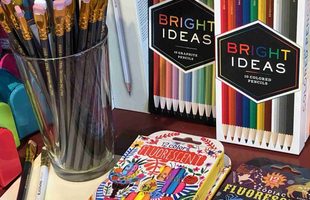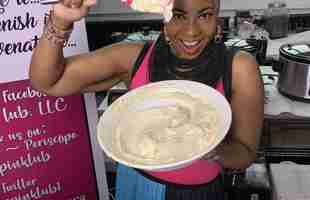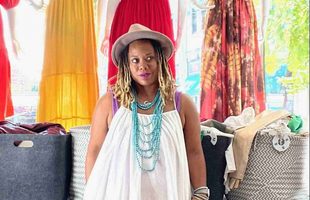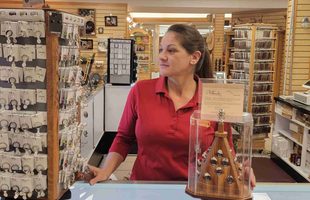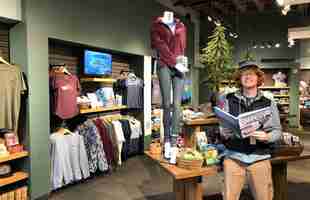By Karen Appold
For some customers at museum shops, money is no object. They’re willing to spend $100, $1,000, or even more. So what appeals most to these clientele?
For Ian Cunningham, operations manager at Crater Rock Museum in Central Point, Ore., jewelry and hand-crafted items made by local artists are some of the higher priced merchandise that sells quickly and for upwards of $300 each. Home décor is among the 1,800-square-foot shop’s most expensive merchandise, and includes amethyst cathedrals ranging from $500 to $7,500 each. “They’re a steady selling item, and the appeal is wide ranging,” he said. “Guests mainly buy them as gifts for others, decorations, collection pieces, and family heirlooms. Because many minerals and gems hold their resale value, they’re a good investment as well.”
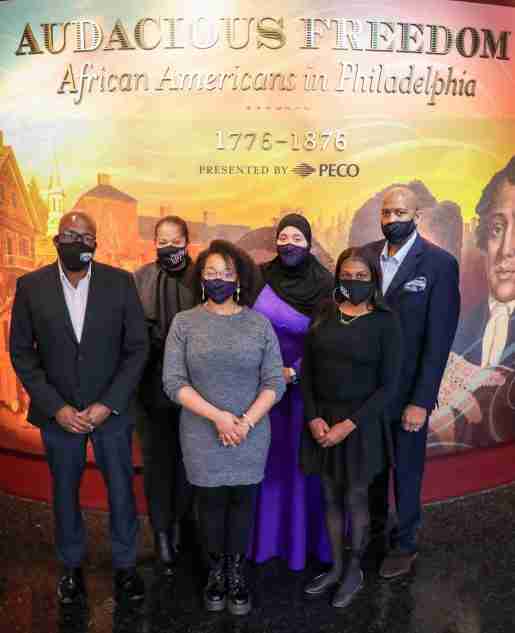 Of the African American Museum AAMP in Philadelphia, shown from left to right: Vice President of Programming Ivan Henderson; Group Sales Coordinator Cassandra Murray Phillips; Gallery Guide Morgan Lloyd; Vice President of Operations Amber Mays; Visitor Services Associate Marcia Gray; and Facility Manager Kirk Dorset. Mays said the book, jewelry, and home décor categories contain some expensive choices that help guests explore the Black experience.
Of the African American Museum AAMP in Philadelphia, shown from left to right: Vice President of Programming Ivan Henderson; Group Sales Coordinator Cassandra Murray Phillips; Gallery Guide Morgan Lloyd; Vice President of Operations Amber Mays; Visitor Services Associate Marcia Gray; and Facility Manager Kirk Dorset. Mays said the book, jewelry, and home décor categories contain some expensive choices that help guests explore the Black experience.Glenn MacPherson, director of the Museum of the American Revolution in Philadelphia, Pa., said the 750-square-foot museum store sells a variety of home décor items for history buffs. Signed prints from artist Don Troiani, who currently has a special exhibit at the museum, are selling well. They range from $120 to $250.
At the 1,500-square-foot shop at the Frazier Kentucky History Museum in Louisville, Ky., a large portion of merchandise is bourbon related. In 2018, the museum was named the official start of the Kentucky Bourbon Trail, so lots of guests start their journey there, said Heidi Janes, manager of visitor services.
Amber Mays, vice president of operations at the African American Museum (AAMP) in Philadelphia, Pa., said that the book, jewelry, and home décor categories have some expensive merchandise. “These items appeal most to our clientele because they assist in exploring the Black experience,” she said. “Through our book selection, customers can learn more about African Americans and people of the African diaspora, which provides them with a better understanding of their cultural and historical relevance. By purchasing jewelry, customers not only support the museum, but they also have the opportunity to support local Philadelphia vendors. Purchasing a home décor item allows customers to share the AAMP experience and our brand outside of the museum’s four walls.”
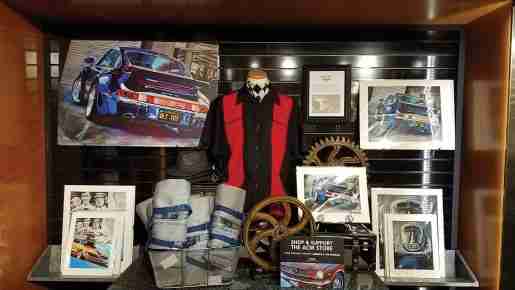 A merchandise display at LeMay – America’s Car Museum in Tacoma, Wash. An $85 book about Lamborghinis sells well for the store.
A merchandise display at LeMay – America’s Car Museum in Tacoma, Wash. An $85 book about Lamborghinis sells well for the store.Best-Sellers
Crystal Buxton, retail manager, LeMay – America’s Car Museum, Tacoma, Wash., said the book, “Lamborghini: Where Why Who When What” by Antonio Ghini,” is a top seller at the 350-square-foot shop. “This classy high-fashion book features beautiful photography of one of the most iconic Italian cars on the market,” she said. It retails for $85.
Alfa Romeo soft shell jackets, knot sweaters, and hats are also top sellers. Provided by local purveyor Tony Schmidt, these high-quality apparel items convey the class and sophistication that are synonymous with the Alfa Romeo Brand. “Alfa fans love to sport their gear and show Italian pride,” Buxton said. Items range from $79 to $120.
Art prints in various sizes including canvas prints from Artist Kelly Telfer are another best-seller for Buxton. “This California-based creator paints a series of racing scenes and iconic sports cars that guests can’t get enough of,” she said. “Images of Porche, McLaren, and Ferrari blazing around corners during well-known races are sure to captivate any European Racing fan.” They are priced from $49.99 to $485.
The Frazier Kentucky History Museum shop sells more than 90 bottles of bourbon that range in price, age, and size. “Many out-of-state tourists want to take home a special bottle of bourbon from Kentucky,” Janes said.
 Amber Mays, vice president of operations at the African American Museum in Philadelphia (AAMP). Mays said jewelry purchases help support both the museum and local Philadelphia vendors.
Amber Mays, vice president of operations at the African American Museum in Philadelphia (AAMP). Mays said jewelry purchases help support both the museum and local Philadelphia vendors.In addition to the liquor itself, U.S.-made granite beverage dispensers sell well for Janes because they are the perfect fixture for an at-home bar. Funky Rock creates these fully functional dispensers that allow any bottle of alcohol to sit atop a gorgeous stone and dispense a beverage.
Bourbon barrel heads are another hit for Janes, as they are plentiful in Kentucky. Bourbon can be aged in new charred oak barrels, so many local artists have designed and personalized parts of the barrels. “They make another great addition to a home bar,” she said.
Cunningham said rock tumblers fly off the shelves as people become more interested in the do-it-yourself side of rock collecting. Amethysts are also popular because they’re beautiful minerals.
For MacPherson, a collector’s book called “Among His Troops: Discovering the Only Known Image of Washington’s Tent,” is a best-seller because it relates to a special exhibit at the museum. “Every guest is wowed by this presentation, so the book is a great addition to the story,” he said.
Jennifer Heslin, director of retail at the Whitney Museum in New York, N.Y., said hand-crafted bioplastic vessels by Artist Caroline Zimbalist sell well. “Each one is unique and has its own personality or
essence,” she said. “They glow in the afternoon sunlight shining into our lobby shop.”
A cozy double-sided blanket by artist Shantell Martin is also popular at the 1,150-square-foot shop at the Whitney Museum. It’s bold and graphic, in a neutral black and cream palette. “It welcomes viewers to ask themselves ‘who are you,’ and then affirms them with a resounding ‘you are you,’” Heslin said. Before COVID, the shop averaged $2.5 million to $3.8 million in sales annually.
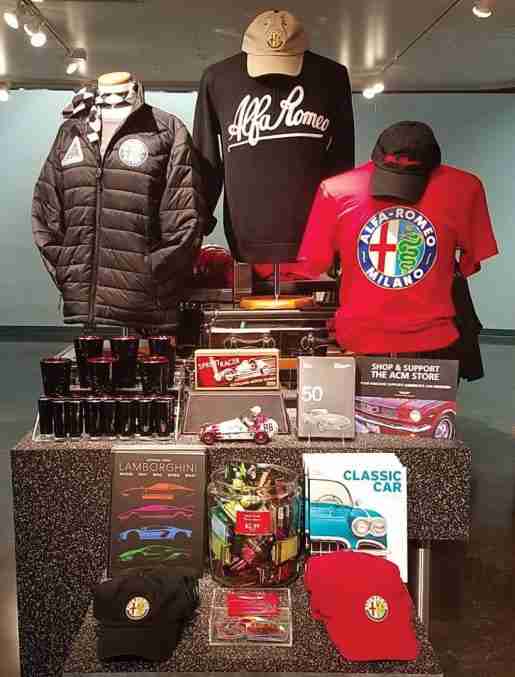 Apparel and souvenir items at LeMay – America’s Car Museum. Alfa Romeo jackets, hats and sweaters are popular at the store.
Apparel and souvenir items at LeMay – America’s Car Museum. Alfa Romeo jackets, hats and sweaters are popular at the store.Drawing Attention to High-End Items
In order to get customers to notice quality gifts, Cunningham has several suggestions. He likes to place high-end items in areas where people will pass by more than once and not just when they enter or exit the gift shop. Lighting that highlights an item’s quality and brings it to people’s attention is also key. He will also rotate items in their own labeled sections because return customers will pass right by items they’re used to seeing. Making a quick video of an item and posting it on social media has also worked well.
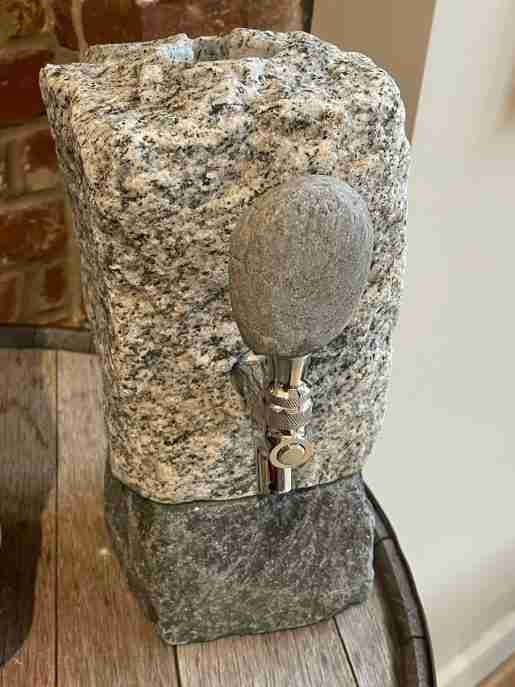 Granite beverage dispensers at the Frazier Kentucky History Museum are made in the United States and sell well.
Granite beverage dispensers at the Frazier Kentucky History Museum are made in the United States and sell well.MacPherson places prints in the front focal window directly opposite the entrance to the exhibit area. “Having products that speak directly to the exhibit helps tremendously,” he said.
When Janes displays related items, she always places them together to create a theme. For instance, all of the shop’s bourbon-related merchandise is in one part of the shop and each table is thematic. “If someone finds one thing they want to purchase, they may spy another one right next to it,” she said.
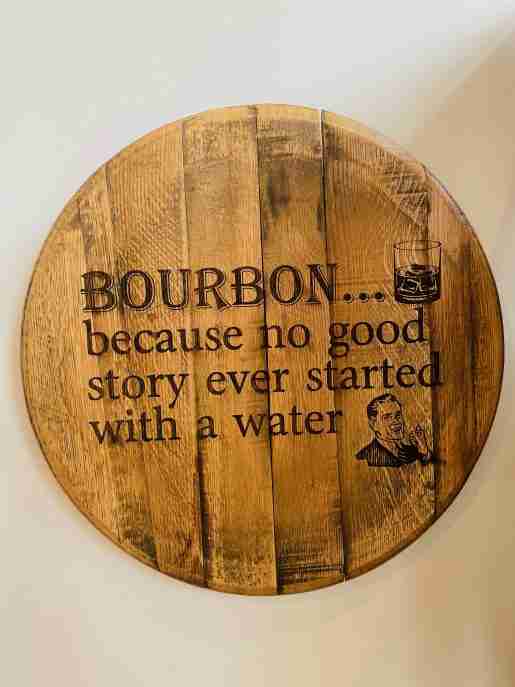 Bourbon-barrel gifts are available at the Frazier Kentucky History Museum in Louisville, Ky.
Bourbon-barrel gifts are available at the Frazier Kentucky History Museum in Louisville, Ky.Well-lit feature tables with products front and center are a great way to grab guests’ eyes. Buxton merchandises high-end items with corresponding impulse or complementary middle-of-the-road items that could be purchased together, creating a story around the theme of the high-end product. “When you can create a well-balanced story that a guest can easily translate, it makes the product more appealing,” she said. The shop garners $395,000 annually.
The Most Popular Least Expensive Gifts
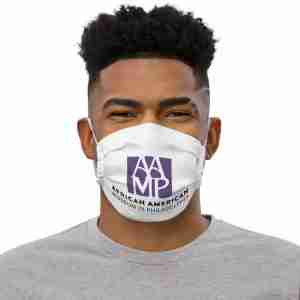 This name-dropped mask is available at the African American Museum in Philadelphia (AAMP) in Philadelphia, Pa. A top-selling inexpensive item for the museum is a $7 AAMP lapel pin, according to the vice president of operations.
This name-dropped mask is available at the African American Museum in Philadelphia (AAMP) in Philadelphia, Pa. A top-selling inexpensive item for the museum is a $7 AAMP lapel pin, according to the vice president of operations.For guests who don’t want to spend a lot at the gift shop, there are lots of popular options. Ian Cunningham, operations manager at Crater Rock Museum in Central Point, Ore., said grab bags are all the rage. They’re filled with local stones that have been tumbled to create a beautiful shine. “At $5, you can’t go wrong,” he said.
M2 Model Kits and die-cast models are by far the most popular less-expensive items at LeMay – America’s Car Museum in Tacoma, Wash., said Crystal Buxton, retail manager. “These toys are highly collectible and have a strong following,” she said. The die-cast models are created in limited edition runs with rare models mixed in. They are highly detailed, and feature makes and models that are very popular with the museum’s demographic. They retail from $9.99 to $19.99.
At the African American Museum (AAMP) in Philadelphia, Pa., Amber Mays, vice president of operations said the AAMP lapel pin, the perfect complement to any blazer or blouse, is a top-selling inexpensive item which is priced at $7.
Jennifer Heslin, director of retail at the Whitney Museum in New York, N.Y., said one-inch pin back buttons by artist Noah Lyon fly off the shelves. “Customers love to comb through them, finding the perfect handful of imaginative drawings featuring themes of political satire, social critique, simple observations, and offbeat humor,” she said.
